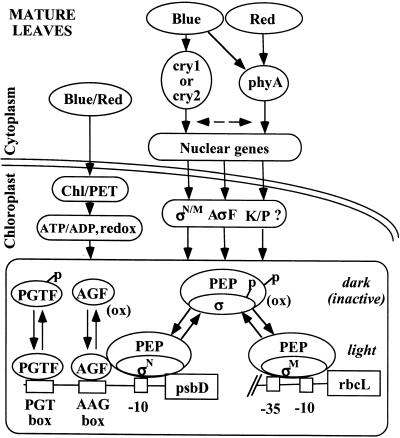Figure 7.
Diagram of Pathways and Components Involved in Light-Regulated Transcription from the psbD-LRP in Light-Grown Plants.
Chloroplast transcription mediated by PEP is modulated by light through the action of chlorophyll (Chl), cryptochrome (cry1, cry2), and phytochrome (phyA). Light-driven photosynthetic electron transport (PET) can modulate chloroplast transcription by changing stromal pH, ATP/ADP and NADPH/NADP ratios, and redox state. Blue light is shown modulating nuclear gene expression through cry1, cry2, and phyA, and red light through phyA. Nuclear genes encoding plastid-localized sigma factors (σ), putative anti-sigma factors (AσF), kinases (K), and phosphatases (P) are shown as possible targets for light regulation. The rbcL promoter contains −10 and −35 promoter elements, whereas the psbD-LRP consists of a −10 element and upstream protein binding sequences (AAG box, PGT box). The activity of PEP, the DNA binding complexes AGF and PGTF, is modulated by phosphorylation, redox state, and possibly the relative abundance of different sigma factors.
Sigma factors (σM, σN/M, σN) designate the involvement of different unspecified sigma factors. Phosphorylated (p) and oxidized (ox) protein complexes are noted.

